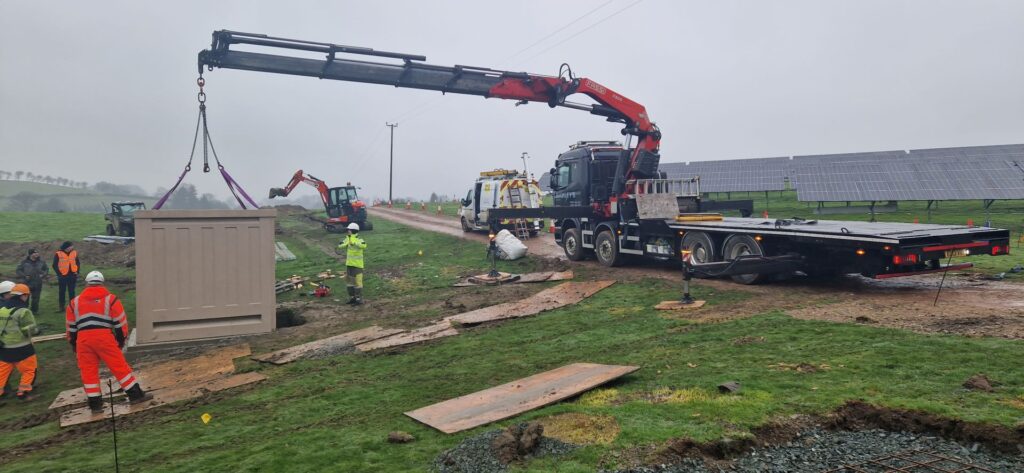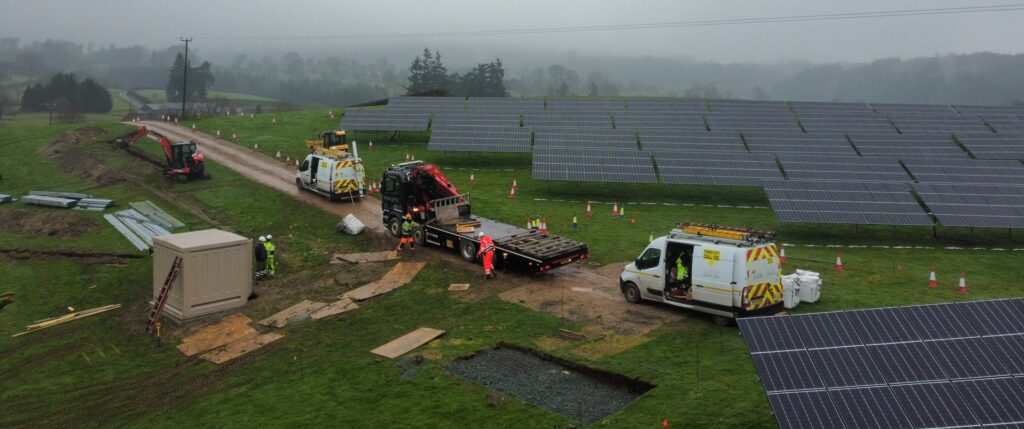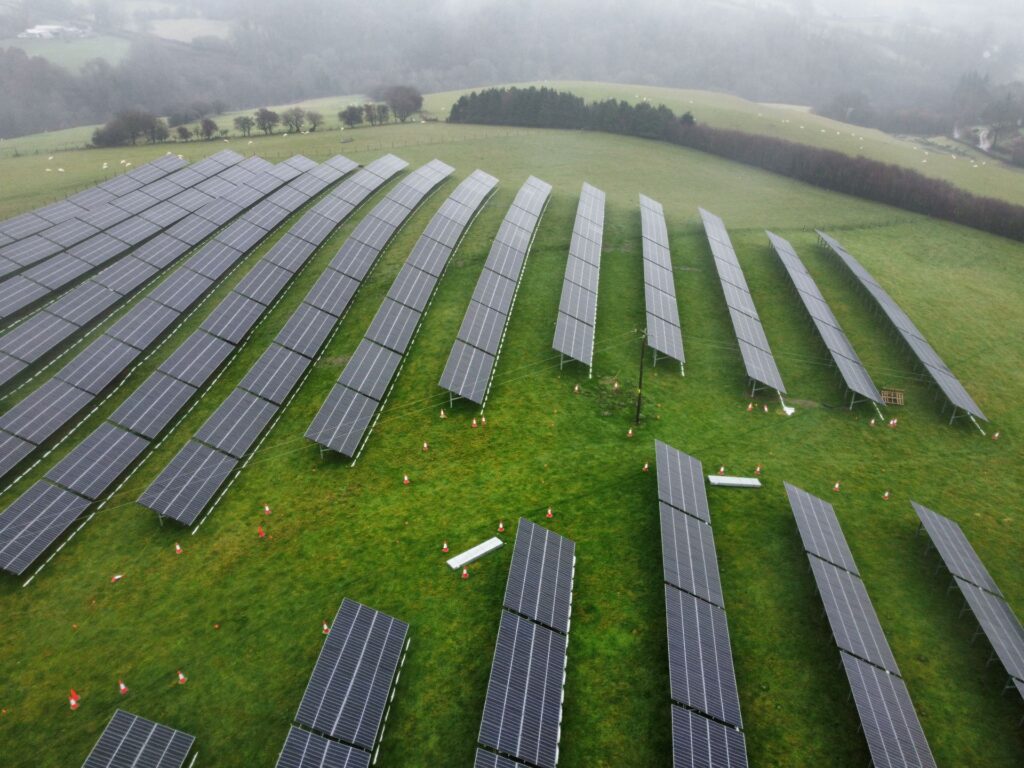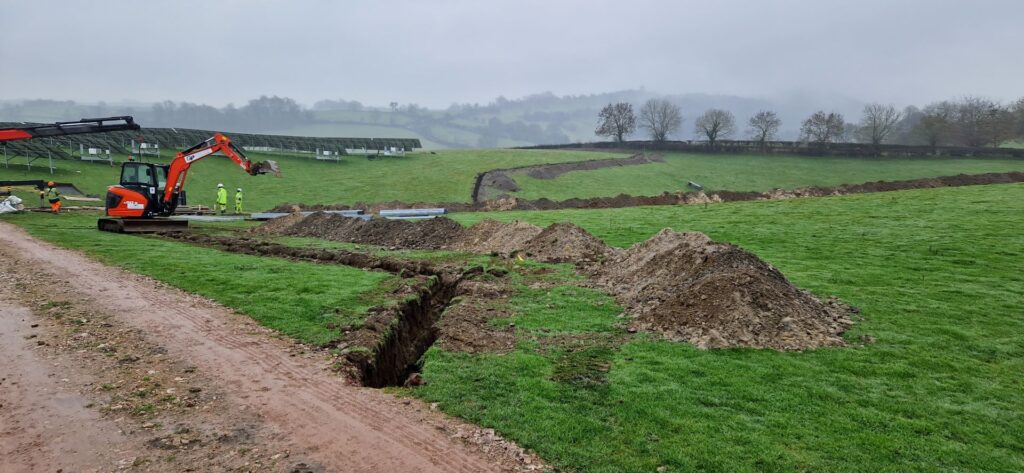Its been a long time since my last visit to the site, and work stalled for ages due to arguments and analysis regarding earthing. Finally at LONG LAST, that was agreed upon, and we could recommence work. I went up there with a friend yesterday in pretty bad wet weather to see what progress there had been. Hopefully this is the start of the final leg of getting the farm finished and connected. When I was last there, most (85%?) of the panels and frames were installed, and most of the inverters, but that was it. This time there was some more stuff done.
The most obvious progress on that day was that the DNO (distribution network operator) people were actually on site installing their substation which includes a transformer. There will eventually be two substations, one for the DNO and one for the site, which will contain the meter and ‘switchgear’. The substation is kind of built on site, out of 4 wall panels and a roof. Here are some cool pics:

Thats the roof being lowered onto the DNO substation, which contains their transformer and other stuff,

A shot taken from my drone (in high winds!) showing the location of stuff. The hole at the bottom of the image, filled with stones is the base for the site substation, which will be built any day now, with our switchgear, and eventually meter. This is where all the underground AC cables from each inverter will meet.

Another drone shot of some of the panels. It was windy and I wasn’t able to get a nice clear image of all of them. The gaps between them in the middle here are where the overhead high voltage cable goes. Once that cable comes down, those gaps will be filled with more panels so there will be nice long uninterrupted lines. Those dotted white lines are actually deposits of snow that have slid off the panels a few days earlier.
We also have a lot of ditches. There are ditches that have been dug for a new underground high voltage line (we queried why this had to be underground, as it costs us WAY more, but were basically just told we had no choice… grrr.), and there are lots of ditches (a ridiculous amount it seemed to me…) for the earthing for the site. The earthing as been a huge, monumental pain in the ass.

So in a sense, this looks like good news right? Not really. There are two huge problems still standing between me and this ever getting finished. The first one is an eight week delay that is being insisted upon before the power can be BRIEFLY cut off to 4 houses so we can remove the overhead line. This is beyond insane, and there is ZERO (I checked) legislative need for this, but as with anything relating to a DNO, you have zero choice. (private monopolies suck). That 8 week delay has not even started yet, because it is, itself being delayed because of lawyers. Yes. Lawyers. FFS.
But the SECOND big problem and nightmare is importing energy. We need (In theory) energy supplied TO the site in order to power the CCTV at night, and I suspect to also actually run the meter itself. This sounds trivial but ALL of the big six energy companies I talked to were incompetent, clueless buffoons who couldn’t even understand what I was asking for. The few clued-up energy companies who did offer a quote to supply energy are quoting a standing charge of £55 a day. Yes thats pounds, not pence. The actual energy usage will be under £50p a day. Yes, I have checked. Yes, this is absolutely totally and utterly insane. There are other charges added too which mean the bill would be about £28,000 a year to run 4 CCTV cameras.
Now you might ask “how the fuck can the standing charge for a business at location X be over a hundred times more than the standing charge for a house at X?”. You might also ask why the fuck the DNO can not provide the power. You might also ask why the fucking fuck we cannot use the power we generated ON SITE and use a tiny backup battery to ‘buffer’ some of it. These are all valid questions, and its driving me insane. Let me explain a bit…
There are two types of electricity meter. A standard domestic one, and whats called half-hourly meters. These are for big businesses and stuff like my farm. They have a different system of standing charges, which are calculated on something called a line-loss factor (LLF). Basically companies stuff power into a line, and meter whats taken out, and note the difference. Remote locations will have high LLFs, as a significant amount of power is lost in transmission (also theft).
In a remote location, a high LLF will mean a high standing charge. Initially we were quoted £186 PER DAY. Now its down to £55 a day, because we had to remind them it was now LV not HV. No, they had not even made that change in their database. Anyway, this is irrelevant, because the whole idea of a LLF affecting a STANDING charge is nuts. I don’t care if 50% of the power on that line is wasted, thats fine, bill me PER UNIT OF POWER 50% higher, I understand. And also…I don’t care because I’ll be importing a trivial, trivial amount of power… but thats not how the UK energy pricing system works. Its for some boneheaded, stupid, illogical and insane reason being placed as a lump sum on the standing charge.
This is beyond stupid. If the LLF is 50% (stupidly high example), and I place an aluminum smelting plant in the Scottish highlands, then I will laugh at your £50/day charge as I demand 10MWH of power every day and you have to stick 20MWH on the line for me to get it. As a large, wasteful, remote high energy consumer, I laugh all the way to the bank. But a tiny, energy efficient company in exactly the same location will pay between 50 and 100x as much for their energy as they should. Absolutely bonkers, insane crazy nonsense. And nobody in the industry gives a damn, or shows any enthusiasm to change it.
Welcome to reason #349 why your UK energy bills are so high, but you can expect the daily mail to blame it on wind turbines or something…
Anyway… there is progress. Its super slow, and unbelievably frustrating and is driving me mad, but there is small progress. One day when all this is done I will celebrate by drinking so much alcohol and eating so many cakes I pass out.